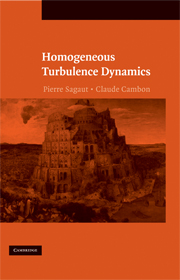Book contents
- Frontmatter
- Contents
- Abbreviations Used in This Book
- 1 Introduction
- 2 Statistical Analysis of Homogeneous Turbulent Flows: Reminders
- 3 Incompressible Homogeneous Isotropic Turbulence
- 4 Incompressible Homogeneous Anisotropic Turbulence: Pure Rotation
- 5 Incompressible Homogeneous Anisotropic Turbulence: Strain
- 6 Incompressible Homogeneous Anisotropic Turbulence: Pure Shear
- 7 Incompressible Homogeneous Anisotropic Turbulence: Buoyancy and Stable Stratification
- 8 Coupled Effects: Rotation, Stratification, Strain, and Shear
- 9 Compressible Homogeneous Isotropic Turbulence
- 10 Compressible Homogeneous Anisotropic Turbulence
- 11 Isotropic Turbulence–Shock Interaction
- 12 Linear Interaction Approximation for Shock–Perturbation Interaction
- 13 Linear Theories. From Rapid Distortion Theory to WKB Variants
- 14 Anisotropic Nonlinear Triadic Closures
- 15 Conclusions and Perspectives
- Bibliography
- Index
11 - Isotropic Turbulence–Shock Interaction
- Frontmatter
- Contents
- Abbreviations Used in This Book
- 1 Introduction
- 2 Statistical Analysis of Homogeneous Turbulent Flows: Reminders
- 3 Incompressible Homogeneous Isotropic Turbulence
- 4 Incompressible Homogeneous Anisotropic Turbulence: Pure Rotation
- 5 Incompressible Homogeneous Anisotropic Turbulence: Strain
- 6 Incompressible Homogeneous Anisotropic Turbulence: Pure Shear
- 7 Incompressible Homogeneous Anisotropic Turbulence: Buoyancy and Stable Stratification
- 8 Coupled Effects: Rotation, Stratification, Strain, and Shear
- 9 Compressible Homogeneous Isotropic Turbulence
- 10 Compressible Homogeneous Anisotropic Turbulence
- 11 Isotropic Turbulence–Shock Interaction
- 12 Linear Interaction Approximation for Shock–Perturbation Interaction
- 13 Linear Theories. From Rapid Distortion Theory to WKB Variants
- 14 Anisotropic Nonlinear Triadic Closures
- 15 Conclusions and Perspectives
- Bibliography
- Index
Summary
This chapter is devoted to the analysis of the interaction of an initially isotropic turbulence with a normal plane shock wave. Even though this case is very simple from a geometrical viewpoint, it will be seen that it involves most physical mechanisms observed in more complex configurations. It also makes it possible to carry out an extensive theoretical analysis, leading to a deep understanding of the underlying physics.
Brief Survey of Existing Interaction Regimes
Several interaction regimes exist, which can be grouped into two families. The first one, referred to as the destructive interaction family, encompasses all configurations in which the structure of the shock wave is deeply modified during the interaction in the sense that a single well-defined shock wave can no longer be identified, the limiting case being the shock destruction. The second family, i.e., the nondestructive interaction family, is made up of all cases in which the structure of the shock wave is preserved during the interaction. It is important to note that, in the latter case, the shock wave can be strongly corrugated by the incoming turbulence.
Destructive Interactions
The first case of destructive interactions is that of unstable shocks, in which any small disturbances will lead to the destruction of the shock wave because of instability mechanisms.
- Type
- Chapter
- Information
- Homogeneous Turbulence Dynamics , pp. 358 - 383Publisher: Cambridge University PressPrint publication year: 2008



